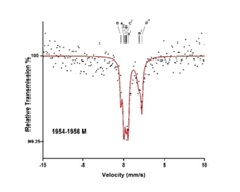Mӧssbauer Spectroscopic Study of Sub – Surface Samples of the DND#28 Well of the Jaisalmer Basin Located in Western Rajasthan, India
DOI:
https://doi.org/10.61343/jcm.v3i01.119Keywords:
Basin, Clay, Mineralogy, Mӧssbauer, SedimentsAbstract
The Jaisalmer Basin is a pericratonic basin located on the northwest slope of the Jaisalmer Mari foundation arch that deepens southwest. With a dip angle of 30 to 50, the basin is late Paleozoic-Mesozoic and is made up of Permian rocks that unconformably rest on Proterozoic foundation. The sedimentary samples of the Pariwar Formation from the Danewala well DND#28 in the Jaisalmer Basin were the subject of the current Mӧssbauer spectroscopic investigation. The primary iron-bearing minerals include siderite, pyrite, and Fe3+ and Fe2+ in clay. When humic organic matter is present, the presence of Fe3+ in clay is more favourable, and siderite indicates that the source rocks are not as mature.
References
G M Bancroft, “Mössbauer Spectroscopy: An Introduction for Inorganic Chemists and Geochemists”, McGraw-Hill. 1973.
S Mørup, J Franck, “Mössbauer spectroscopy study of the chemical state of iron in Danish Mesozoic sediments”, Fuel, 64: 528–538,1985.
Curtis, C. D., “Geochemistry of diagenesis in sediments. In A. Parker & B. W. Sellwood (Eds.)”, Sediment diagenesis,15–34,1983.
Canfield, D. E., “Reactive iron in marine sediments”, Geochimica et Cosmochimica Acta, 53: 619–632, 1989.
Berner, R. A., “A new geochemical classification of sedimentary environments”, Journal of Sedimentary Petrology, 51: 359–365,1981.
Froelich, P. N., “Early oxidation of organic matter in pelagic sediments of the eastern equatorial Atlantic: suboxic diagenesis”, Geochimica et Cosmochimica Acta, 43: 1075–1090, 1979.
Tucker, M. E., “Sedimentary petrology: An introduction to the origin of sedimentary rocks”, Wiley-Blackwell, 2001.
Reed, S. J. B., “Electron microprobe analysis”, Cambridge University Press, 1993.
Hawthorne, F. C., “Mössbauer spectroscopy. In F. C. Hawthorne (Ed.), Spectroscopic methods in mineralogy and geology”, Mineralogical Society of America: 255–274, 1988.
Coey, J. M. D., “Mössbauer spectroscopy of iron in clay minerals. In J. E. Firth (Ed.), Clay minerals: Their structure, properties, and uses”, Royal Society of Chemistry: 191–206,1984.
S Ram, “Distribution of iron in siderite in sub-surface sediments of Jaisalmer Basin (India) using Mössbauer spectroscopy”, Fuel, 77: 1507–1512,1998.
B Bhatia, “Mössbauer spectroscopic study of sediments collected from test wells drilled in the Bikaner-Nagaur Basin”, Fuel, 98: 140–148,2012.
R P Tripathi, “Fe Mössbauer spectroscopy study of organic rich sediments (source rocks) from test well CT-1, Chinnewala structure of Jaisalmer basin, India”, Geosciences Frontiers, XXX: 1–6,2015.
S S Meena, “Mössbauer Spectroscopic Study of the Sedimentary Samples Collected from Barmer Hill Formation of Northern Barmer Basin, Western Rajasthan (India)”, IJIRET, 5: 1558–1560,2016.
S S Meena, “Fe Mössbauer Spectroscopic Study of Sedimentary Samples from Goru Formation in Well MNW-1 of Jaisalmer Basin, Rajasthan, India”, Journal of Pure and Applied Science & Technology, 7: 18–26,2017.
R Pandey R, A S Maurya, “Hydrocarbon Uncertainty Based on Facies Analysis: Middle Jurassic Sequence (Jaisalmer Formation), Jaisalmer Basin, Rajasthan”, Journal Geological Society of India, 95:301307,2020.
M Bohra, “Mössbauer spectroscopy study of Samples from Cambay Shale Formation, Cambay Basin, in context of Shale Oil”, Journal Geological Society of India, 96: 603608, 2020.
S Ram, “Estimation of Environment of Sedimentary Deposition in Parh Formation of Tertiary Sediments of Jaisalmer Basin, Rajasthan, India”, Applied Ecology and Environmental Sciences, 10: 802805,2022.
A N Nigam, R P Tripathi, H S Singh, R S Gambhir and N G Lukose, “Mössbauer studies on Ghotaru Well No.1 of Jaisalmer Basin”, Fuel, 68:209212,1989.
E V Meerwall, “A least-squares spectral curve fitting routine for strongly overlapping Lorentzians or Gaussians”, Computer Physics Communications, 9: 117–128,1975.

Downloads
Published
How to Cite
License
Copyright (c) 2025 Hemant Dhaka, Samay Singh Meena

This work is licensed under a Creative Commons Attribution 4.0 International License.
Copyright© by the author(s). Published by journal of Condensed Matter. This is an open access article distributed under the terms of the Creative Commons Attribution (CC BY) license (https://creativecommons.org/licenses/by/4.0/), which permits unrestricted use, distribution, and reproduction in any medium, provided the original author(s) and source are credited.









